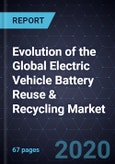NMC Batteries Will Become a Profitable Proposition in Terms of Recycling; LFP Batteries Will Have Higher Reuse Value
China will continue to dominate the electric vehicle (EV) battery reuse and recycling market because it is the world’s largest EV market. The rising number of EVs on the road is anticipated to increase the cost of the key materials used in batteries (lithium and cobalt, for example).
To reduce their dependence on the import of key materials from other countries, many companies have decided to construct their own facilities for the recycling of batteries. Existing recycling methods are based on chemical extraction processes tailored for single, specific elements (mainly, lithium and cobalt). The need of the hour is a new technology/solution that will help to overcome the challenge of having separate extraction processes for various elements.
Given the challenges battery disposal presents, recycling works as an opportunity to increase profit margins and decrease footprint, which will act as additional benefits for stakeholders. Battery manufacturers are working on a unified design that will be easy to dismantle; information can also be shared about battery controlling systems' interfaces and communication protocol.
Collaborations between private and public entities will become an important strategy for effective advanced vehicle battery recycling. Innovative business models such as the Tesla-Umicore partnership create arrangements that are as good for the company as they are for the community; they also demonstrate how a recycling system can be both profitable and environmentally sound. Supportive regulations that focus on the recycling of Li-ion batteries will alleviate material scarcity, lower material costs, and reduce energy usage, emission, and mining-related impacts. Robust investments in collection and recycling infrastructure and technology for new-generation vehicle batteries, along with effective regulations, will promote higher collection and recycling rates for Li-ion batteries.
Table of Contents
1. Executive Summary
- 2019 Highlights
- Li-ion Batteries - Types of Chemistries
- Li-ion Battery Portfolio and Battery Chemistry Value Chain
- The Journey of the Li-ion Battery
- Responsibility Scenarios
- Key Trends Impacting the Market
2. Research Scope and Segmentation
- Research Scope
- Research Aim and Objectives
- Key Questions this Study will Answer
- Research Background
- Research Methodology
3. Global EV Battery Reuse and Recycling Market Outlook
- 2019 Highlights
- Recovery Process for Used Li-ion Batteries
- Recycling of Batteries
- Li-ion Batteries - Types of Recycling Methodologies and Comparison
- Key Trends Impacting the Market
- Challenges and Barriers in the Battery Recycling Process
4. Chemistry of Li-ion Batteries
- Li-ion Batteries - Types of Chemistries
- Li-ion Batteries - Types of Chemistries
- Li-ion Battery Portfolio and Battery Chemistry Value Chain
- Li-ion Batteries - Adoption Trend by OEMs
5. Reuse and Recycling Methods and Value Chain
- The Journey of the Li-ion Battery
- Design for the Disassembly of EV Battery Packs
- Li-ion Batteries - Recycling Value Chain
- Responsibility Scenarios
- Battery Recycling Companies
- Li-ion Batteries - Recycling Value Chain (Basic Outline)
- Service and Collection
- Dismantling and Sorting
- Battery Quality Check
- Battery Reuse
- Second-Life Battery Application
- Battery Scrap
- Battery Material Refining
- Battery Remanufacturing
6. Existing Business Models
- Existing Reuse and Recycle Business Models
7. Reuse and Recycling Policies
- Recycling and Reuse of EV Li-ion Batteries
- Outlook for Battery Reuse and Recycling Policies - US and Canada
- Outlook for Battery Reuse and Recycling Policies - Europe
- Outlook for Battery Reuse and Recycling Policies - China
8. Growth Opportunities and Companies to Action
- Growth Opportunities
- Strategic Imperatives
9. Key Conclusions
10. Appendix
- Market Engineering Methodology
- List of Exhibits
Companies Mentioned (Partial List)
A selection of companies mentioned in this report includes, but is not limited to:
- Tesla
- Umicore








